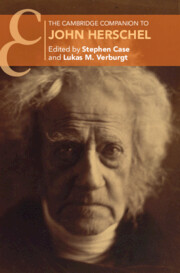Book contents
- The Cambridge Companion to John Herschel
- The Cambridge Companion to John Herschel
- Copyright page
- Contents
- Figures
- Contributors
- Acknowledgments
- Chronology
- Introduction
- 1 John Herschel
- 2 The Mathematical Journey of John Herschel
- 3 John Herschel’s Astronomy
- 4 Stargazer at World’s End
- 5 Herschel’s Philosophy of Science
- 6 Drawing Observations Together
- 7 Photology, Photography, and Actinochemistry
- 8 Herschel’s Planet
- 9 John Herschel and Scientific Standardization
- 10 John Herschel and Politics
- 11 John Herschel’s Methodology in the Scientific Community
- Further Reading
- Index
3 - John Herschel’s Astronomy
Published online by Cambridge University Press: 08 May 2024
- The Cambridge Companion to John Herschel
- The Cambridge Companion to John Herschel
- Copyright page
- Contents
- Figures
- Contributors
- Acknowledgments
- Chronology
- Introduction
- 1 John Herschel
- 2 The Mathematical Journey of John Herschel
- 3 John Herschel’s Astronomy
- 4 Stargazer at World’s End
- 5 Herschel’s Philosophy of Science
- 6 Drawing Observations Together
- 7 Photology, Photography, and Actinochemistry
- 8 Herschel’s Planet
- 9 John Herschel and Scientific Standardization
- 10 John Herschel and Politics
- 11 John Herschel’s Methodology in the Scientific Community
- Further Reading
- Index
Summary
Despite John Herschel’s extensive work in the fields of chemistry, optics, geology, mineralogy, and the philosophy of science, it was primarily as an astronomer that he was recognized during his lifetime and remembered after his death. Herschel’s astronomical endeavors can be summarized as establishing and extending the astronomical projects of his father William Herschel (1738–1822) and his aunt Caroline Herschel (1750–1848). By establishing, Herschel brought an observational and mathematical rigor to his father’s observations that transformed them from the results of an individual with unique instrumentation to data useful and accessible to the wider astronomical community. By extending, Herschel continued the observational program of his father and aunt, revisiting his father’s observations, updating his catalogs of double stars, nebulae, and star clusters, and extending the Herschelian project to the skies of the southern hemisphere. Yet the observational aims and methods of William and Caroline Herschel were markedly different from the astronomy being pursued by most other astronomers during their lifetimes. To understand John Herschel’s long astronomical career and influence, an overview of the scope and aims of the dominant form of astronomy during this period is needed that can provide the background to the work of his father and aunt and the context of his own.
- Type
- Chapter
- Information
- The Cambridge Companion to John Herschel , pp. 55 - 76Publisher: Cambridge University PressPrint publication year: 2024



